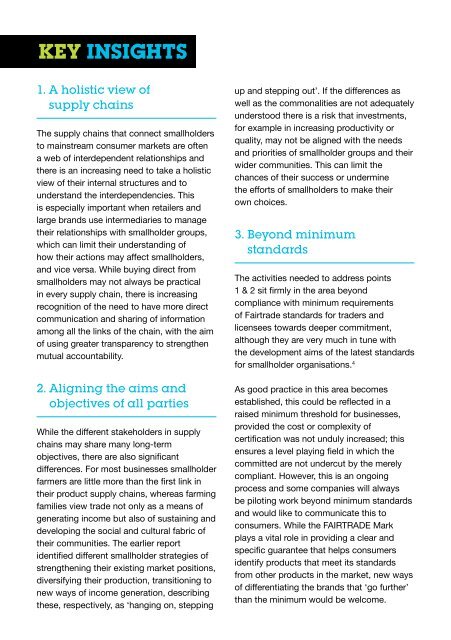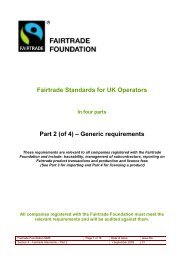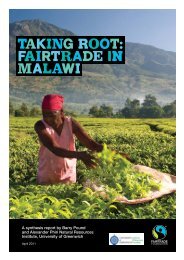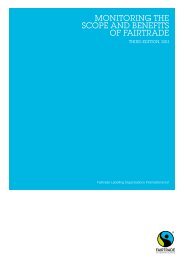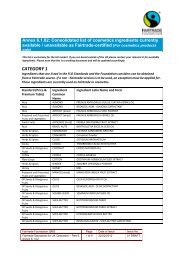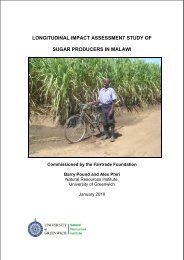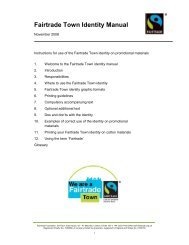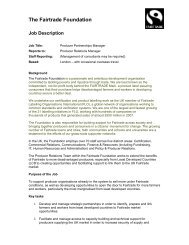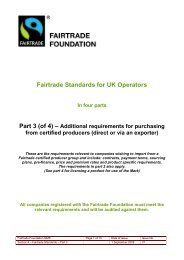executive summary - The Fairtrade Foundation
executive summary - The Fairtrade Foundation
executive summary - The Fairtrade Foundation
You also want an ePaper? Increase the reach of your titles
YUMPU automatically turns print PDFs into web optimized ePapers that Google loves.
key insigHts<br />
1. A holistic view of<br />
supply chains<br />
<strong>The</strong> supply chains that connect smallholders<br />
to mainstream consumer markets are often<br />
a web of interdependent relationships and<br />
there is an increasing need to take a holistic<br />
view of their internal structures and to<br />
understand the interdependencies. This<br />
is especially important when retailers and<br />
large brands use intermediaries to manage<br />
their relationships with smallholder groups,<br />
which can limit their understanding of<br />
how their actions may affect smallholders,<br />
and vice versa. While buying direct from<br />
smallholders may not always be practical<br />
in every supply chain, there is increasing<br />
recognition of the need to have more direct<br />
communication and sharing of information<br />
among all the links of the chain, with the aim<br />
of using greater transparency to strengthen<br />
mutual accountability.<br />
2. Aligning the aims and<br />
objectives of all parties<br />
While the different stakeholders in supply<br />
chains may share many long-term<br />
objectives, there are also significant<br />
differences. For most businesses smallholder<br />
farmers are little more than the first link in<br />
their product supply chains, whereas farming<br />
families view trade not only as a means of<br />
generating income but also of sustaining and<br />
developing the social and cultural fabric of<br />
their communities. <strong>The</strong> earlier report<br />
identified different smallholder strategies of<br />
strengthening their existing market positions,<br />
diversifying their production, transitioning to<br />
new ways of income generation, describing<br />
these, respectively, as ‘hanging on, stepping<br />
up and stepping out’. If the differences as<br />
well as the commonalities are not adequately<br />
understood there is a risk that investments,<br />
for example in increasing productivity or<br />
quality, may not be aligned with the needs<br />
and priorities of smallholder groups and their<br />
wider communities. This can limit the<br />
chances of their success or undermine<br />
the efforts of smallholders to make their<br />
own choices.<br />
3. Beyond minimum<br />
standards<br />
<strong>The</strong> activities needed to address points<br />
1 & 2 sit firmly in the area beyond<br />
compliance with minimum requirements<br />
of <strong>Fairtrade</strong> standards for traders and<br />
licensees towards deeper commitment,<br />
although they are very much in tune with<br />
the development aims of the latest standards<br />
for smallholder organisations. 4<br />
As good practice in this area becomes<br />
established, this could be reflected in a<br />
raised minimum threshold for businesses,<br />
provided the cost or complexity of<br />
certification was not unduly increased; this<br />
ensures a level playing field in which the<br />
committed are not undercut by the merely<br />
compliant. However, this is an ongoing<br />
process and some companies will always<br />
be piloting work beyond minimum standards<br />
and would like to communicate this to<br />
consumers. While the FAIRTRADE Mark<br />
plays a vital role in providing a clear and<br />
specific guarantee that helps consumers<br />
identify products that meet its standards<br />
from other products in the market, new ways<br />
of differentiating the brands that ‘go further’<br />
than the minimum would be welcome.


